
Conclusion (RX Vega 64)
The RX Vega 64 is an answer to the GTX 1080, but currently it's not a whole lot more than that, and it's not an especially great answer either. AMD appears to have had to sacrifice a lot by way of thermals and power consumption – things it has long struggled with in the GPU space – in order to match GTX 1080 performance with the Vega 10 GPU. The fact that the GTX 1080 launched over a year ago but still presents a significant challenge to AMD when it comes to performance and is in fact still more efficient than AMD's latest and greatest is a fairly damning headline that will be tough for AMD to escape.

We suspect that under water and with basically all concerns for efficiency thrown to the wind, the RX Vega 64 could improve by more and be truly unleashed, but AMD is asking for $200 more for its liquid-cooled card, which is pretty substantial, and we wonder how well it will compare to similarly priced Nvidia SKUs. We will just have to wait and see, and the same applies to the situation with custom water-cooling – the card is definitely ripe for being tamed by water, so hopefully there are some good water blocks in the works.
As we said before, FreeSync is perhaps AMD's strongest asset, and it could be the Vega 64's only saving grace. Variable refresh rate gaming really is worth going for if at all possible, and FreeSync is a considerably less expensive alternative to G-Sync. The GTX 1080 is the better card overall, but if you only care about performance and maximising bang for buck, the RX Vega 64 with a FreeSync screen is very viable and possibly better solution than the GTX 1080 with a comparable G-Sync monitor. However, even then, we have to reserve any recommendations for third-party cards (due September), as the reference cooler here is not quite up to the task and won't let you get the most from your card. Thankfully, the RX Vega 64 is not the only card that AMD launched, which brings us to...

MSI MPG Velox 100R Chassis Review
October 14 2021 | 15:04








Want to comment? Please log in.